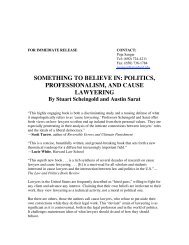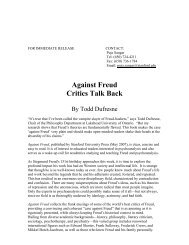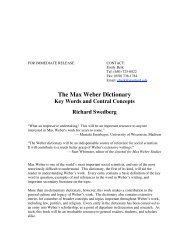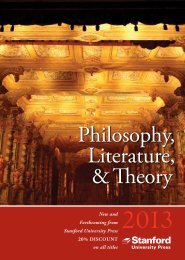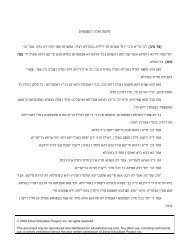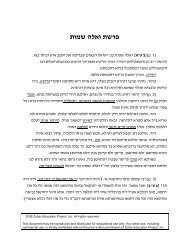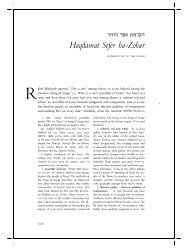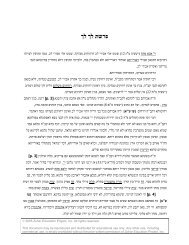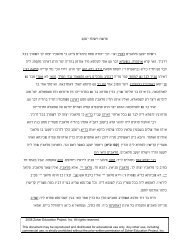Front Matter (PDF) - Stanford University Press
Front Matter (PDF) - Stanford University Press
Front Matter (PDF) - Stanford University Press
You also want an ePaper? Increase the reach of your titles
YUMPU automatically turns print PDFs into web optimized ePapers that Google loves.
a constant search for ``hints'' within the text that will allow for an<br />
words,<br />
deeper levels of interpretation. This careful attention to the text is<br />
openingto<br />
to the Zohar's readiness to apply to it the symbolic language of the<br />
joined<br />
that we have discussed above. It is the interplay between these two<br />
se®rot<br />
heightened midrashic sensitivity and the old/new grid of se®rotic<br />
factors,<br />
that creates the unique and powerful poesis of the Zohar.<br />
symbols,<br />
element that plays a key role in the powerful impression the Zohar<br />
Another<br />
made on its readers throughout the generations is the sonorous and seem-<br />
has<br />
mysterious Aramaic in which it is written. All the sections of the Zohar,<br />
ingly<br />
for about half of Midrash ha-Ne'lam, are written in Aramaic rather than<br />
except<br />
While scholars have devoted much attention to the unique grammatical<br />
Hebrew.<br />
and syntactical features of the Zohar's Aramaic, few have tried to under-<br />
why it is that the Zohar is written in Aramaic and what meaningthis<br />
stand<br />
choice of language might have had for the work's authors.<br />
surprising<br />
was the spoken language of Jews, both in the land of Israel and in<br />
Aramaic<br />
from late biblical times (fourth±third century b.c.e.) until after the<br />
Babylonia,<br />
conquest and its replacement by Arabic (seventh century c.e.) .The<br />
Islamic<br />
in both its Babylonian and Palestinian versions, is composed mostly in<br />
Talmud,<br />
as are portions of Midrash and other rabbinic writings. The Targum,<br />
Aramaic,<br />
several versions, is the old Jewish translation of the Bible into<br />
existingis<br />
Aramaic.<br />
the time the Zohar was written, Aramaic was a purely literary language<br />
By<br />
all but a tiny group of Jews in the mountains of Kurdistan. Knowledge of it<br />
for<br />
was purely passive, even amongrabbinic scholars; only very rarely<br />
elsewhere<br />
a short treatise or poem still written in Aramaic. The choice to compose<br />
was<br />
Zohar in Aramaic gave to the work an archaic cast, and this immediately<br />
the<br />
the stage for its mysterious quality.<br />
set<br />
Spain of the thirteenth century, unlike Palestine of the second, Aramaic<br />
In<br />
a mysterious and only vaguely understood language. Presenting secrets in<br />
was<br />
rather than Hebrew (a method that had been tried, in brief texts,<br />
Aramaic<br />
the Zohar) shrouded them in an obscuringveil, forcinga slower pace of<br />
before<br />
upon those who delved into its pages. It also permitted a certain gran-<br />
reading<br />
that might have seemed pretentious in the more familiar vehicle of<br />
diloquence<br />
Hebrew. Images that might have been seen as trivial in Hebrew,<br />
medieval<br />
if frequently repeated, maintained a certain mysterious grandeur<br />
especially<br />
veiled by the obscurity of Aramaic dress.<br />
when<br />
Zohar's Aramaic made the text slightly, but not impossibly, more<br />
The<br />
for the educated Jewish reader in its day. This was probably the<br />
dif®cult<br />
intent: to offer the reader a sense that he had come to a more profound,<br />
precise<br />
and therefore less penetrable, sort of teaching. With some extra effort, it<br />
reveal to him the secret universe that the Zohar sought to share and pass<br />
would<br />
to its elite community of readers. Students of the Zohar come quickly to<br />
on<br />
Introduction<br />
lxx<br />
understand that the Aramaic of the Zohar is indeed a penetrable veil. The real



